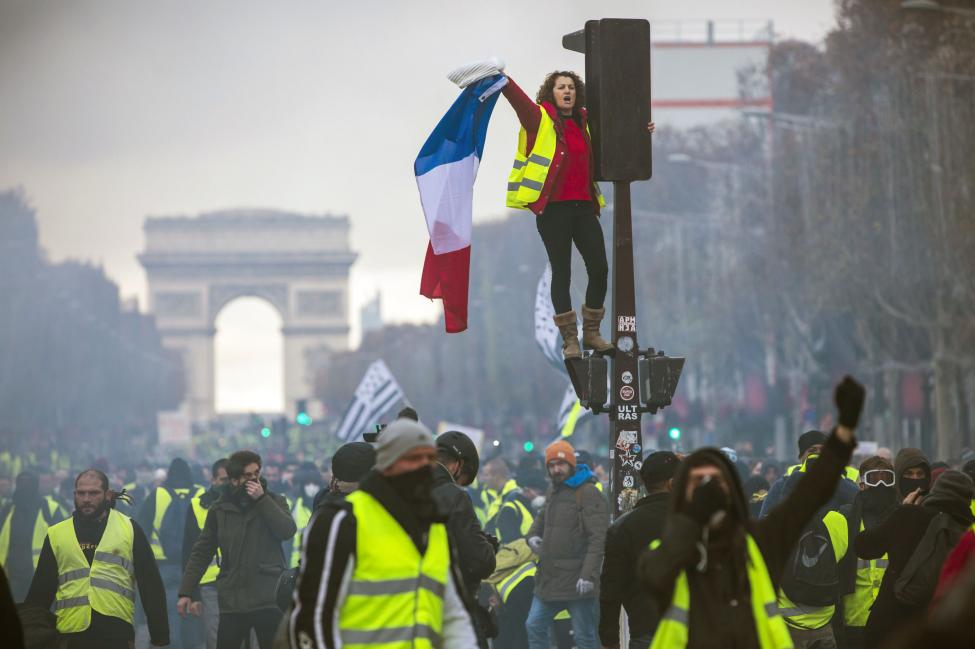
Yellow Vest protesters marching on the Champs Élysées in Paris
The last Saturday in March marked “Act XX” for the the Gilets Jaunes or Yellow Vests protests, the 20th consecutive weekend citizens have marched in the tens of thousands and occupied traffic roundabouts across France. Since hundreds of thousands mobilized out of the blue on November 17 to protest President Emmanuel Macron’s new gasoline tax, justified as combating global warming, the movement has forced the government into multiple concessions and a virtual stop to its neoliberal reform program, inspired imitators far and wide, and provoked debate on the Left and across the political spectrum, in France and abroad, as to its nature and prospects. Protesters in Belgium, the UK, Germany and Hungary have donned the dramatic garb for their own purposes, not to mention in Algeria and Iraq (Tunisians wore red vests instead). Both Hungarian authoritarian Prime Minister Viktor Orbán and Egyptian strongman President Abdel Fattah el-Sisi are reported to have temporarily banned the retail sale of such garments, to forestall their use by regime opponents. So the yellow vest has clearly emerged as the icon of new kind of protest. But what are its politics? Or, perhaps the more important question: what does the appearance and persistence of this movement say about the political moment?

Anti-regime protesters in Algeria sport yellow vests
Precursors to the explosion were the spread of “anger groups” (groupes colère) on Facebook at the beginning of last year, expressing indignation at the difficulties in getting by in smaller cities, towns and villages. A reduction last summer of the speed limit on smaller highways spawned a concerted backlash, including sabotage of speed-monitoring cameras. The new fuel tax, just five percent on top of the price of widely used diesel, which had however already risen substantially in the year and a half since Macron had taken office (it is now well over six dollars a gallon), was the proverbial straw that broke the camel’s back. Calls to mobilize circulating on social media bypassed political parties, unions and all other traditional civil society groups, and brought out huge numbers, most of which had never demonstrated before or even been politically engaged, from “left-behind” France. The yellow vests, which all drivers are legally required to carry (at their own expense, as some pointed out), gave them high visibility—as did violence directed against the Arc de Triomphe, luxury shops on the Champs Elysees and the police. Despite the violence, and attempts by government spokespeople and many Parisian intellectuals to paint them as anti-environmental, anti-immigrant and inspired by right-wing populism (and perhaps by Russian meddling as well), initial public opinion polls showed support for the gilets jaunes’ cause at 70-80% or more.
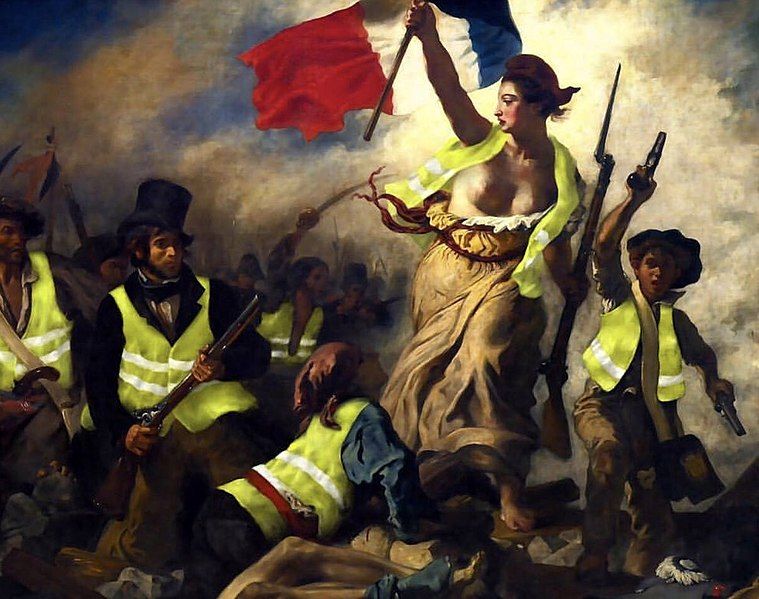
Marianne, the symbol of the French Republic, also supports the movement (an updated version of the 1830 painting “Liberty Leading the People” by Eugène Delacroix)
To be sure, there was also wide support on the Left for this uprising, seemingly able to paralyze business as usual across the country week in and week out. But both the anti-establishment Left (Jean-Luc Mélenchon’s La France Insoumise—Unbowed France) and Right (Marine Le Pen’s Rassemblement National—National Rally, formerly the National Front) were themselves left behind by a phenomenon neither had seen coming. Both have since been trying, without much success, to gain a foothold in a mobilization almost fanatically opposed to political organizations, and even to leadership structure within. (Yellow Vests did join an action by the Leftist Confédération Générale du Travail—General Confederation of Labor on February 5.) This is a sign of the alienation from politics of French, and more broadly Western, citizens, also seen in the Brexit referendum in the UK and support for Trump here, but in the Occupy Wall Street movement as well.

Leftist union CGT joins December protest
The Globalizers and the Others
The gilets jaunes come from what geographer Christophe Guilluy has called “peripheral France,” and what other commentators have identified as the “precarious ranks of the lower middle class.” Macron’s project to streamline the state and economy, mobilize finance to strengthen the EU and save the climate, and turn France into a “start-up nation” has accelerated a process that has created great wealth in Paris and other regional centers, while exacerbating inequality and de-developing everywhere else. This has left the “non-bobos” (bourgeois-bohemians) in forgotten landscapes where public (and personal) budgets are ever-tightening, social services are declining and the very fabric of life seems to be decaying. The neglect of public transportation beyond the metropolises and the high-speed rail that connects them have left these people, who are by and large regularly employed but struggling to make ends meet, completely dependent on their cars and the fossil fuel that feeds them. Rising real estate prices have pushed many out of the cities where relatively green transport options exist. President Macron’s uber-elite pedigree and isolation from their reality, which they also impute—with good reason—to the entire political class and the media, has generated intense resentment. Thus a common refrain at the protests, referring to the President’s climate engagement: “Macron talks about the end of the world while we are talking about [surviving until] the end of the month.” (Macron faced heavy criticism for being on a ski trip—the French equivalent of US presidential golf—during renewed violence at a mid-March “Act.”) Many activists have expressed support for climate action, but questioned why they should bear the bulk of the sacrifice.
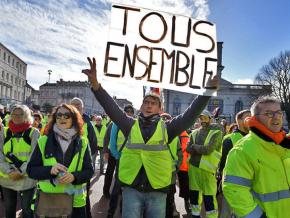
The sign reads “All Together”
Aside from the gilets jaunes’ ambiguous politics, the state response in terms of police violence should give any civil libertarian pause. Anti-terrorist laws and rhetoric have been employed in Paris and other urban sites of—admittedly striking—destruction, and some physical attacks on police and others. (The violence can largely be attributed to “black bloc” anarchists, and right-wing counterparts, though not a few critics, including some on the Left, have tarred the whole movement as casseurs, or troublemakers.) Security forces have deployed rubber projectile launchers and so-called “sting-ball” grenades, quasi-military weapons used nowhere else in Europe for crowd control, resulting in some 20 lost eyes and a lesser number of lost hands among protesters, and the death of an elderly woman watching from her apartment. Anti-terrorist army troops have been drafted into service, marking the first domestic use of the military since a miners’ strike more than 70 years ago.
A more sticky charge against the gilets jaunes is that of anti-Semitism, especially after a verbal assault on Jewish writer Alain Finkielkraut (despite his having declared his support for the protests). Slogans attacking Macron as a tool of his former employer Rothschild bank, long at the center of conspiracy theories postulating Jewish control of the levers of capitalism, are also problematic. But there is a compelling argument that such expressions reflect the prejudices (and this also applies to racism and homophobia, both of which have been charged) swirling around French society, rather than fomenting them. Though the 25-point “manifesto” circulated online—itself of uncertain representativeness—does call for immigration restrictions, the overwhelming emphasis of gilets jaunes demands is on economic measures such as a rise in welfare benefits and the minimum wage, tax cuts and the restoration of the “solidarity tax on wealth” abolished by Macron—and on a more direct democracy.
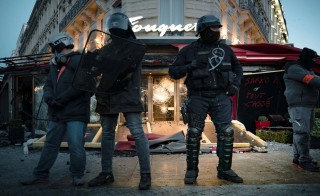
Riot police guard the luxury restaurant and presidential haunt Le Fouquet after its destruction during a yellow vest demonstration
A New Form of Representation
This push for a new kind of political representation is perhaps the most interesting aspect of the gilets jaunes. Macron, after canceling the gas tax and raising the minimum wage, embarked on a “Great Debate,” appearing (and speechifying, usually at great length) at numerous organized forums, while setting in motion a process that has led to thousands of others across the country. The movement’s response was its own organization of an “assembly of assemblies,” which, if not setting a clear direction (though instituting a citizens’ referendum process is a major demand), allowed for a unique form of expression and representation. The irony is that Macron himself came to power by bypassing existing political parties, labor unions and other representative structures, only to be challenged by a movement operating in the same way. Two different efforts at elective participation to channel the protests’ energy into action have recently been launched, accompanied by a stark backlash against them by democratic purists.
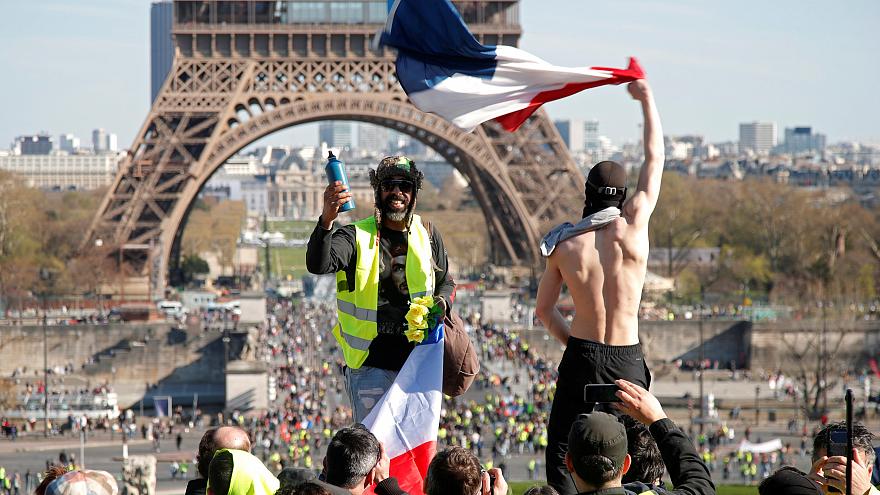
Demonstrations have targeted the most familiar symbols of France
Bold assessments propelled by the drama of the gilets jaunes, such as that they have “reshaped the political landscape in Europe,” or that they are “striking a new body blow to the teetering edifice of neoliberalism” (both from the leftist Counterpunch) may be hyperbolic, but it is clear that French politics will never be the same. The banlieues, the even more struggling mostly immigrant suburbs, have been absent from the actions, but there are efforts to connect the constituencies. While a reactionary turn is a possibility, a progressive direction is certainly open to the movement. This could prove the potential of the idea of “Left populism,” whose “fundamental assertion,” according to Dissent, is that “the division between the people and the elite can be made more salient than the division between left and right.”
